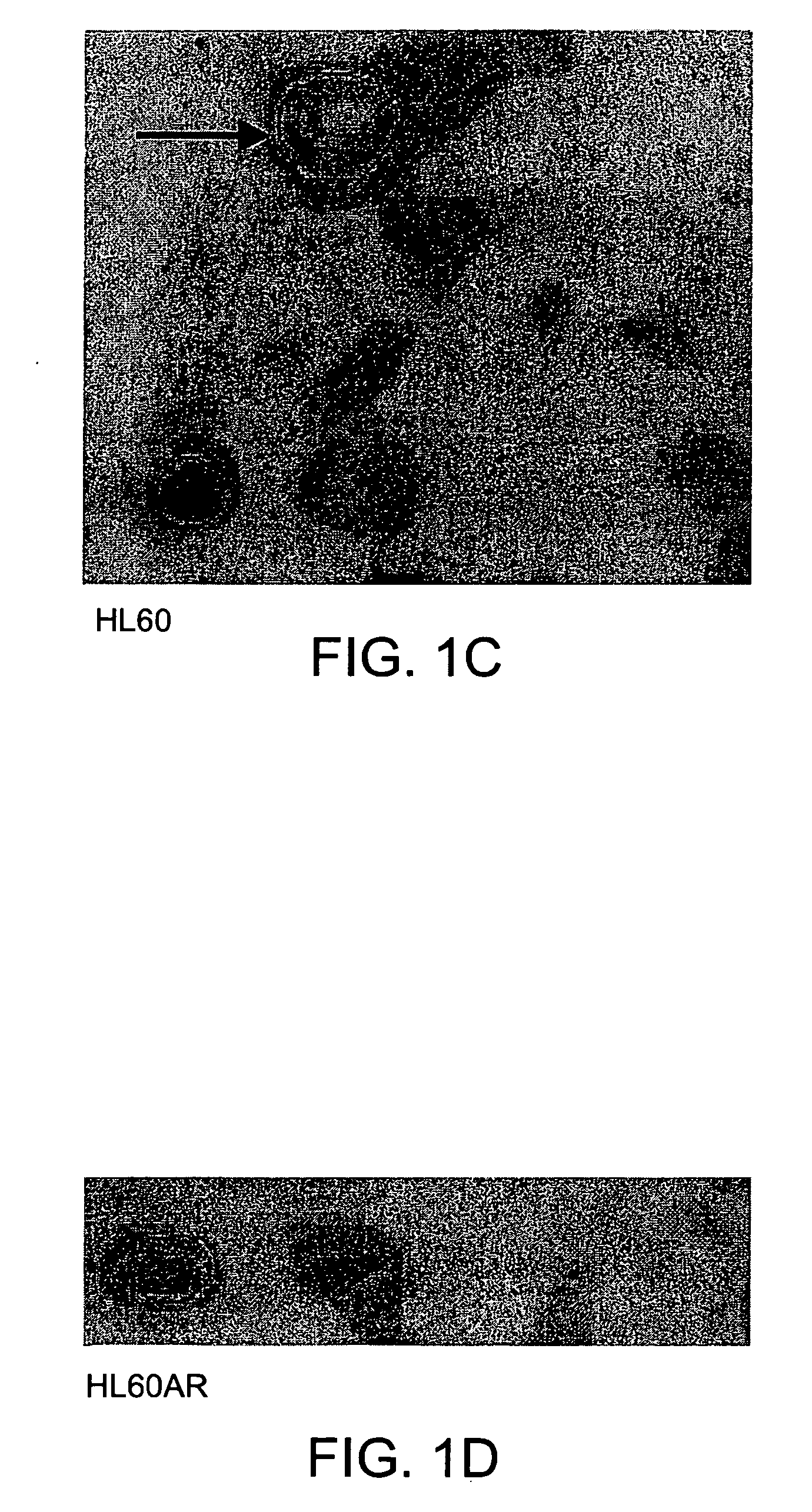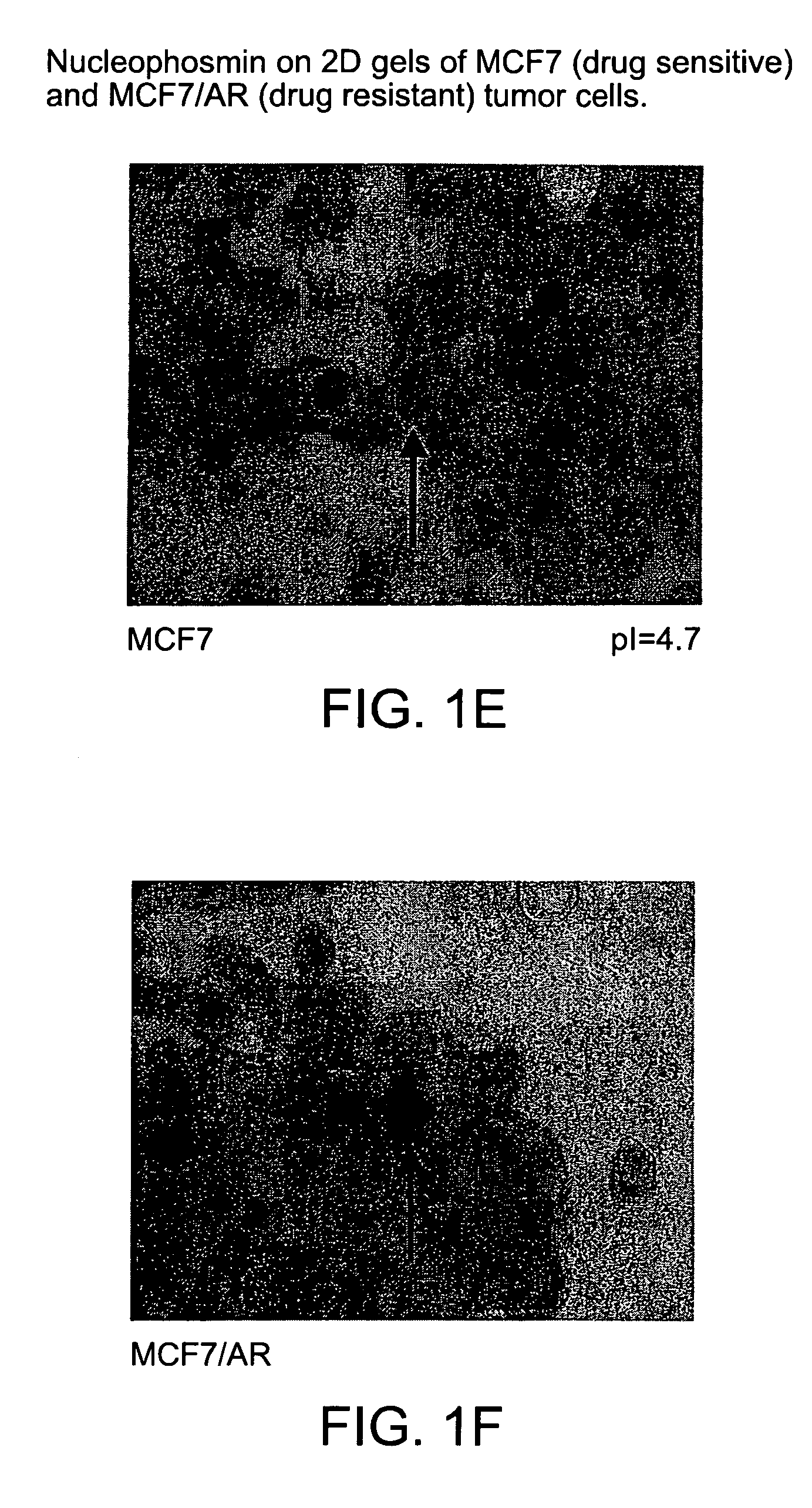Nucleophosmin directed diagnostics and therapeutics for multidrug resistant neoplastic disease
a multi-drug resistant, neoplastic disease technology, applied in the direction of material testing goods, biochemistry apparatus and processes, cancer antigen ingredients, etc., can solve the problems of cancer patients and non-cancer patients with diseas
- Summary
- Abstract
- Description
- Claims
- Application Information
AI Technical Summary
Benefits of technology
Problems solved by technology
Method used
Image
Examples
example 1
[0351] 5.1 Overexpression of a 32 kDa Protein in Membranes of Multidrug Resistant SolidTumor / Cancer Cells
[0352] Studies were performed to determine what proteins, if any, were differentially expressed in multidrug resistant tumor cell lines as compared to their drug-sensitive counterparts.
[0353] A. Cells
[0354] The five different cell lines used are described in Table I below.
1TABLE I Multidrug resistant cell line derived from a clone of the Cancer cell tissue Drug-sensitive "parent" drug-sensitive cell type "parent" cell line line Source of cells Promyelocytic HL60 HL60AR American Tissue leukemia Culture Collection (ATCC), Manassas, VA and McGill University Promyelocytic NB4 NB4 / VLB Deutsche Sammlung leukemia NB4 / DOX von Midroorganismen und Zellkulturen GmbH (DSMZ, Germany) & Aurelium BioPharma T lymphoblastoid CEM CEM / VLB ATCC and Dr. William CEM / AR Beck, Aurelium T lymphoblastoid HSB2 HSB2 / VLB ATCC and Aurelium HSB2 / DOX BioPharma T lymphoblastoid Molt4 Molt4 / DOX ATCC and Aurelium ...
example 2
[0370] 5.2 The 32 kDa Protein is Expressed Extracellularly on Cell Membranes of Multidrug Resistant Tumor Cells
[0371] To determine whether the 32 kDa protein in MDR cells was present on the inside or outside of the cell membrane, intact cells of drug-sensitive HL60 cells, and multidrug resistant HL60AR cells were reacted with a membrane impermeable biotinylating reagent that reacts with the amino acid lysine, and total cell extracts from both drug sensitive HL60 cells and multidrug resistant HL60AR cells were resolved by one dimensional SDS-PAGE and Western blot with streptavidin-HRP conjugate (Amersham, Piscataway, N.J.; RPN 1231). The streptavidin moiety binds tightly to biotin and the HRP (horse radish peroxidase) moiety yields a colored or chemiluminescent product when reacted with substrate.
[0372] To do this, cells were biotinylated by washing 3.times. with 50 ml PBS, pH 8. Next, Sulfo-NHS-LC-LC-Biotin (Pierce Chemicals), which is a membrane impermeable reagent, was prepared at...
example 3
[0377] 5.3 Identification of the 32 kDa Protein as Nucleophosmin (B23)
[0378] To discover the identity of the 32 kDa protein of HL60, HL60AR, MCF7, and MCF7 / AR cells (spots pointed to by the arrow on the gels shown in FIGS. 1A-1F), two replicate 2-D gels were loaded with the same biotinylated HL60AR membrane extract used in FIG. 1B (2.times.750 .mu.g, pI 4 to 7, 10% gel), the gels were silver-stained, and the 32 kDa spots were excised. The spots were next processed using optimized procedures for staining / destaining of gels, trypsin digestion, peptide extraction and peptide purification. To do this, briefly, gels were stained with the SilverQuest silver stain (Invitrogen) using the recipe given by the manufacturer. The protein spots of interest were excised with a clean (i.e., acid washed) razor blade and cut into small pieces on a clean glass plate and transferred into a 200 .mu.l PCR tube (MeOH treated).
[0379] Next, 50 .mu.l destainer A and 50 .mu.l destainer B (provided with Silver...
PUM
| Property | Measurement | Unit |
|---|---|---|
| ionic strength | aaaaa | aaaaa |
| ionic strength | aaaaa | aaaaa |
| time interval | aaaaa | aaaaa |
Abstract
Description
Claims
Application Information
 Login to View More
Login to View More - R&D
- Intellectual Property
- Life Sciences
- Materials
- Tech Scout
- Unparalleled Data Quality
- Higher Quality Content
- 60% Fewer Hallucinations
Browse by: Latest US Patents, China's latest patents, Technical Efficacy Thesaurus, Application Domain, Technology Topic, Popular Technical Reports.
© 2025 PatSnap. All rights reserved.Legal|Privacy policy|Modern Slavery Act Transparency Statement|Sitemap|About US| Contact US: help@patsnap.com



